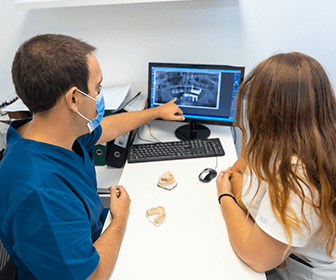Dental implants are a common technique used to replace teeth lost due to decay, damage, or aging. In order to carry out this treatment, patients need enough maxillary bone density. But, can people have dental implants with bone loss? The answer is yes! But first, let’s understand why bone loss affects dental implants.
Dental implants differ from dental bridges and dentures because they attach directly to the jaw bone. It is very simple: dental implants are anchored with a screw inserted into the bone. This way, the artificial tooth or teeth cover the screw and look and feel just like natural teeth.
In this sense, when teeth are missing, the jawbone begins to lose its strength since the normal force and pressure from the tooth are no longer on that part of the bone.
Periodontal disease, decay, and illness, among other causes, can also weaken the jawbone. So, if the bone is not strong enough to support the dental implants, there are only two ways to solve the problem: zygomatic dental implants or bone grafts.
What are zygomatic dental implants?
Zygomatic implants are a more straightforward solution than bone grafts and are designed to help patients get dental implants with bone loss.
A zygomatic dental implant uses a particular bone implanted into the upper or lower jaw bone. Dentists prefer the zygomatic bone—also known as the cheekbone—because it remains strong.
As a result, dental implants can still be used even if a patient suffers severe bone loss. Another benefit of zygomatic dental implants is that they heal faster than bone grafts, which are generally faster and easier.
Bone Grafts and Dental Implants

A bone graft is a more complex procedure but can be highly effective. Besides making dental implants possible, a bone graft can help strengthen the jawbone and restore face shape, chewing, and speaking comfort while preventing further damage.
During a bone graft, a section of healthy bone is implanted into the damaged area. Remember that the bone is a living tissue, so weakened or damaged, it can incorporate the grafted bone as it heals.
However, this process takes longer. The weakened bone will take at least from 3-4 months to incorporate the healthy bone and become stable enough for a dental implant. Then, the dental implant process will also require recovery time.
If you are considering dental implants services, but are concerned about bone loss, call us today! Our multidisciplinary team of experts at Previa Implant Center can give you more information and help you decide on the best option. With over 35 years of experience, we offer dental implants in Tijuana treatments so you can get your smile back.
Why do patients prefer us? Because we analyze your jaw and set of teeth through a dental implant consultation before taking any decision. We have the most advanced technology for tomographies, QX planning, and surgical guide, which allows us to offer you a minimally invasive surgery! Do not hesitate and make an appointment today! Let your smile be in the best hands.


